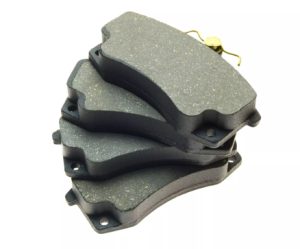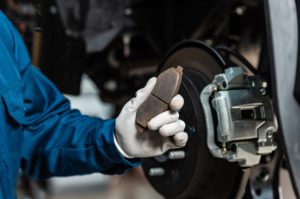Choosing the right brake pads is crucial for your vehicle’s safety, performance, and driving comfort. Among the many options available, three main types dominate the market: ceramic, semi-metallic, and organic brake pads. Each has its own set of advantages and drawbacks, making them suitable for different driving styles, vehicle types, and budgets.
In this article, we’ll compare ceramic, semi-metallic, and organic brake pads to help you decide which is best for your car. We’ll cover their composition, performance, lifespan, noise levels, and cost, supported by tables and lists for clarity.
What Are Brake Pads Made Of?

Brake pads consist of a friction material bonded to a backing plate. The friction material generates the stopping force when pressed against the brake rotors. The type of friction material largely determines the pad’s characteristics.
1. Ceramic Brake Pads
Composition: Ceramic brake pads are made from ceramic fibers, bonding agents, and small amounts of metal fillers like copper or steel. They offer a modern, high-tech approach to braking.
Advantages:
-
Quiet operation with minimal noise and vibration.
-
Produce less brake dust, keeping wheels cleaner.
-
Excellent durability and long lifespan.
-
Stable performance across a wide temperature range.
-
Less wear on brake rotors compared to other types.
Disadvantages:
-
Typically more expensive than other types.
-
Not ideal for heavy-duty or high-performance vehicles that generate extreme heat.
2. Semi-Metallic Brake Pads
Composition: These pads are made of 30-65% metal fibers (steel, copper, iron) mixed with graphite and other fillers to improve friction.
Advantages:
-
Excellent heat dissipation, making them good for high-performance or heavy vehicles.
-
Provide strong stopping power even under extreme conditions.
-
Generally less expensive than ceramic pads.
Disadvantages:
-
Can be noisy, producing a squealing or grinding sound.
-
Create more brake dust, which can dirty wheels.
-
More abrasive to rotors, leading to faster rotor wear.
3. Organic Brake Pads (Non-Asbestos Organic – NAO)
Composition: Made from natural materials like rubber, carbon compounds, glass, and resins. Historically, some contained asbestos, but modern organic pads are asbestos-free.
Advantages:
-
Quieter braking experience.
-
Softer on rotors, reducing rotor wear.
-
Usually the most affordable option.
Disadvantages:
-
Shorter lifespan compared to ceramic and semi-metallic pads.
-
Performance can degrade in high heat or heavy use.
-
Produce more dust than ceramic pads but less than semi-metallic.
Comparison Table: Ceramic vs. Semi-Metallic vs. Organic Brake Pads
| Feature | Ceramic | Semi-Metallic | Organic |
|---|---|---|---|
| Material Composition | Ceramic fibers + metal fillers | 30-65% metal fibers + fillers | Natural fibers + resins |
| Noise Level | Quiet | Noisy | Quiet |
| Brake Dust | Low | High | Moderate |
| Rotor Wear | Low | High | Low |
| Performance (Heat) | Good for moderate heat | Excellent for high heat | Poor at high heat |
| Durability | Long-lasting | Long-lasting | Shorter lifespan |
| Cost | High | Moderate | Low |
| Best Use | Daily driving, comfort | Performance, towing, heavy loads | Light driving, budget cars |
Which Brake Pads Are Best for Your Driving Needs?
Choosing the right brake pads depends on your driving habits, vehicle type, and budget. Here’s a quick guide:
-
Daily Commuters & City Drivers:
Ceramic brake pads are often the best choice due to their quiet operation, low dust, and longevity. -
Performance and Heavy-Duty Drivers:
Semi-metallic pads excel here, providing excellent heat tolerance and stopping power for sporty driving, towing, or trucks. -
Budget-Conscious or Light-Duty Drivers:
Organic brake pads offer good value and quieter operation but require more frequent replacement.
Additional Factors to Consider

-
Weather Conditions:
Semi-metallic pads tend to perform better in wet or cold weather because they generate heat faster. Ceramic pads can sometimes struggle to reach optimal operating temperature quickly in cold conditions. -
Brake Rotor Compatibility:
If you have expensive or high-performance rotors, ceramic or organic pads are gentler and help prolong rotor life. -
Environmental Concerns:
Organic and ceramic pads tend to produce less harmful dust than semi-metallic pads, making them better for the environment.
Summary Checklist: Choosing Brake Pads
| Question | Recommended Brake Pad Type |
|---|---|
| Do you want quiet, clean braking? | Ceramic |
| Do you need strong braking for heavy loads? | Semi-metallic |
| Are you on a tight budget? | Organic |
| Do you drive mostly in the city? | Ceramic |
| Do you drive aggressively or tow heavy loads? | Semi-metallic |
| Do you prioritize rotor longevity? | Ceramic or Organic |
Final Thoughts
No single type of brake pad fits all vehicles and driving styles perfectly. Ceramic, semi-metallic, and organic brake pads each offer unique benefits and compromises. Understanding your driving habits and vehicle needs is key to making the right choice.
For everyday drivers looking for quiet and clean performance, ceramic brake pads are an excellent investment. For those who demand more aggressive braking and durability under stress, semi-metallic pads are a robust choice. Meanwhile, organic pads remain popular for budget-conscious drivers and lighter-duty vehicles.
Where to Buy Quality Brake Pads
Looking for reliable brake pads tailored to your car and driving needs? You can explore a wide selection of ceramic, semi-metallic, and organic brake pads at trusted suppliers.
Buy Car Brake Pads online — find the perfect fit for your vehicle with trusted brands and fast delivery.
If you want your car to stop safely and smoothly, choosing the right brake pads is one of the best maintenance investments you can make. Consider your driving style, vehicle type, and local conditions before making your decision. Safe driving!